
Intellectual Property Rights (IPR), National IPR Policy
Subscribers of "Current Affairs" course can Download Daily Current Affairs in PDF/DOC
Subscribe to Never Miss an Important Update! Assured Discounts on New Products!
Must Join PMF IAS Telegram Channel & PMF IAS History Telegram Channel
Intellectual Property Rights (IPR)
- Intellectual Property Rights (IPR) are the rights acquired by an owner of an intellectual property.
- Intellectual property is a category of property that includes intangible creations of the human intellect.
- In simple terms, it refers to creations of the mind, such as
- inventions
- literary & artistic works
- designs & symbols,
- names & images used in commerce.
- The main purpose of intellectual property law is to
- encourage the creation of a wide variety of intellectual goods &
- strike the right balance between the interests of innovators & wider public interest.
Laws & Rules that govern Intellectual Property Rights (IPR)
- The importance of IPR was first recognized in the
- Paris Convention for the Protection of Industrial Property (1883) &
- Berne Convention for the Protection of Literary & Artistic Works (1886).
- Both are administered by the World Intellectual Property Organization (WIPO).
- IPRs have been outlined in Article 27 of the Universal Declaration of Human Rights.
- WTO governs IPR through Trade-Related Aspects of the Intellectual Property Rights (TRIPS).
World Intellectual Property Organization (WIPO)
- WIPO is one of the 15 specialized agencies of the United Nations (UN).
- WIPO was created to promote and protect intellectual property (IP) across the world by cooperating with countries as well as international organizations.
- It began operations in 1970.
- Headquarters: Geneva, Switzerland.
- WIPO currently has 193 member states.
- WIPO’s activities include
- hosting forums to discuss and shape international IP rules and policies,
- providing global services that register and protect IP in different countries,
- resolving transboundary IP disputes,
- helping connect IP systems through uniform standards and infrastructure, and
- serving as a general reference database on all IP matters.
Trade-Related Aspects of the Intellectual Property Rights (TRIPS)
- TRIPS is an international agreement on intellectual property rights.
- The Agreement covers most forms of intellectual property including
- patents,
- copyright,
- trademarks,
- geographical indications,
- industrial designs,
- trade secrets, &
- exclusionary rights over new plant varieties.
- It came into force in 1995 & is binding on all members of the World Trade Organization (WTO).
Types of Intellectual Property
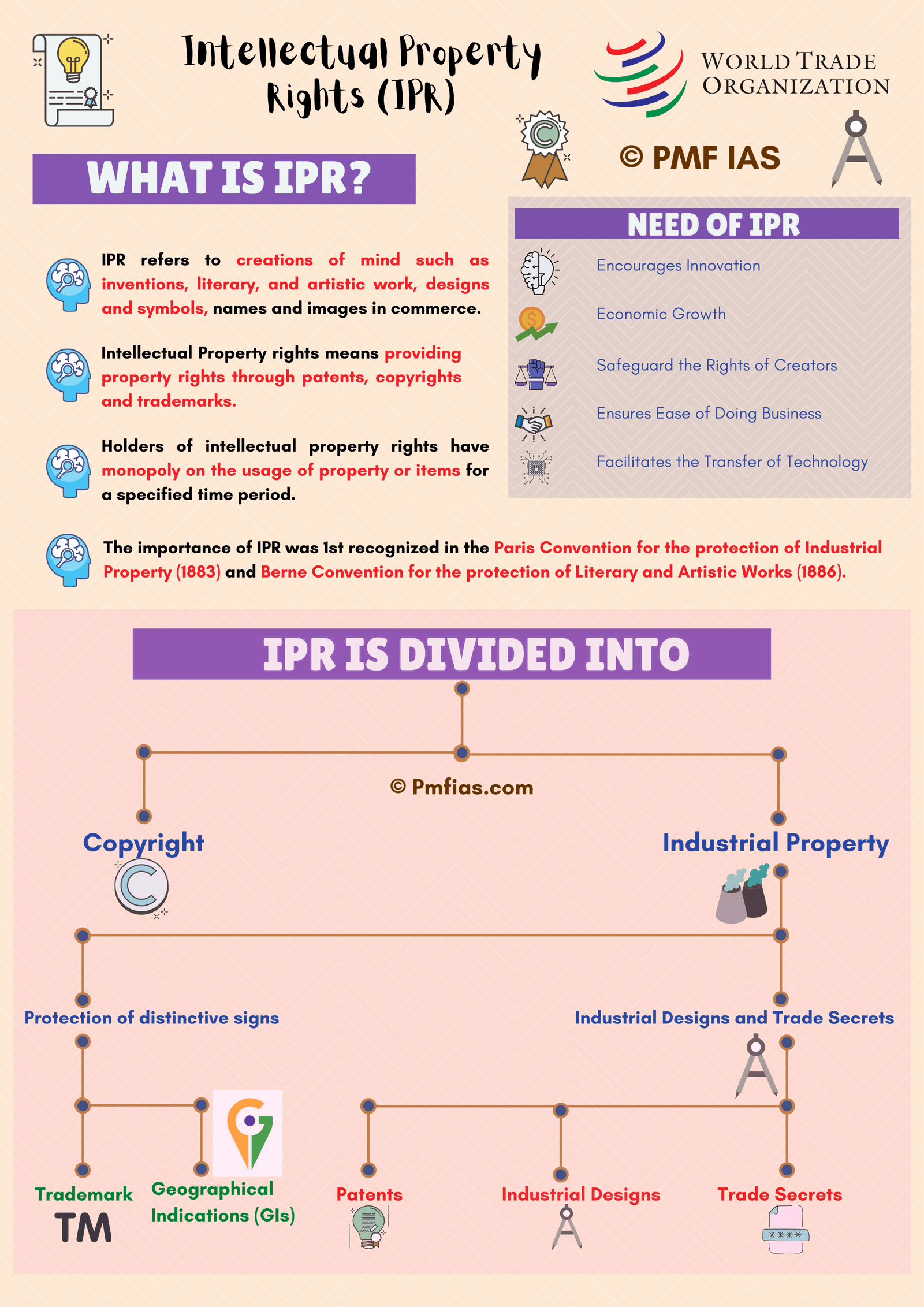
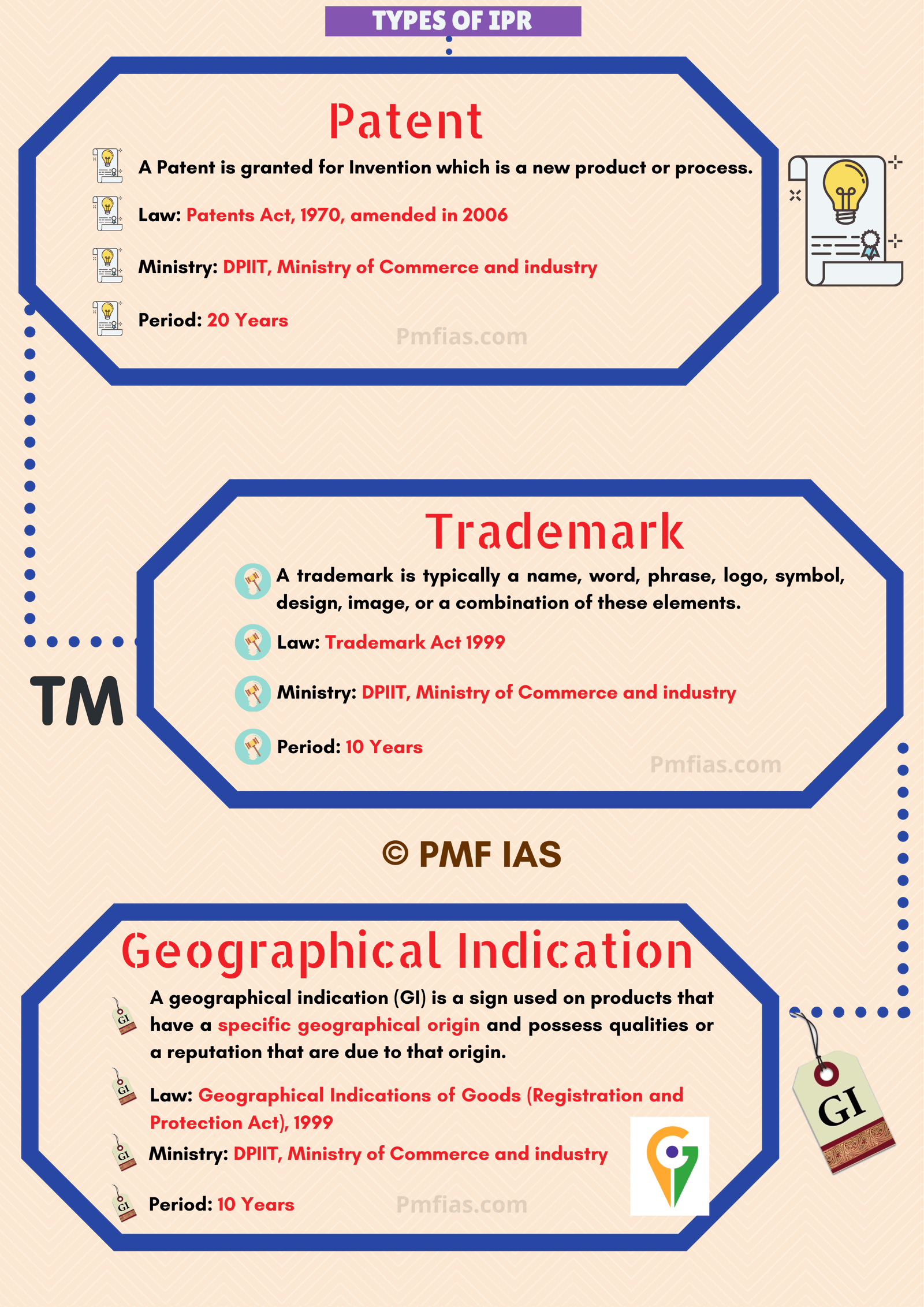
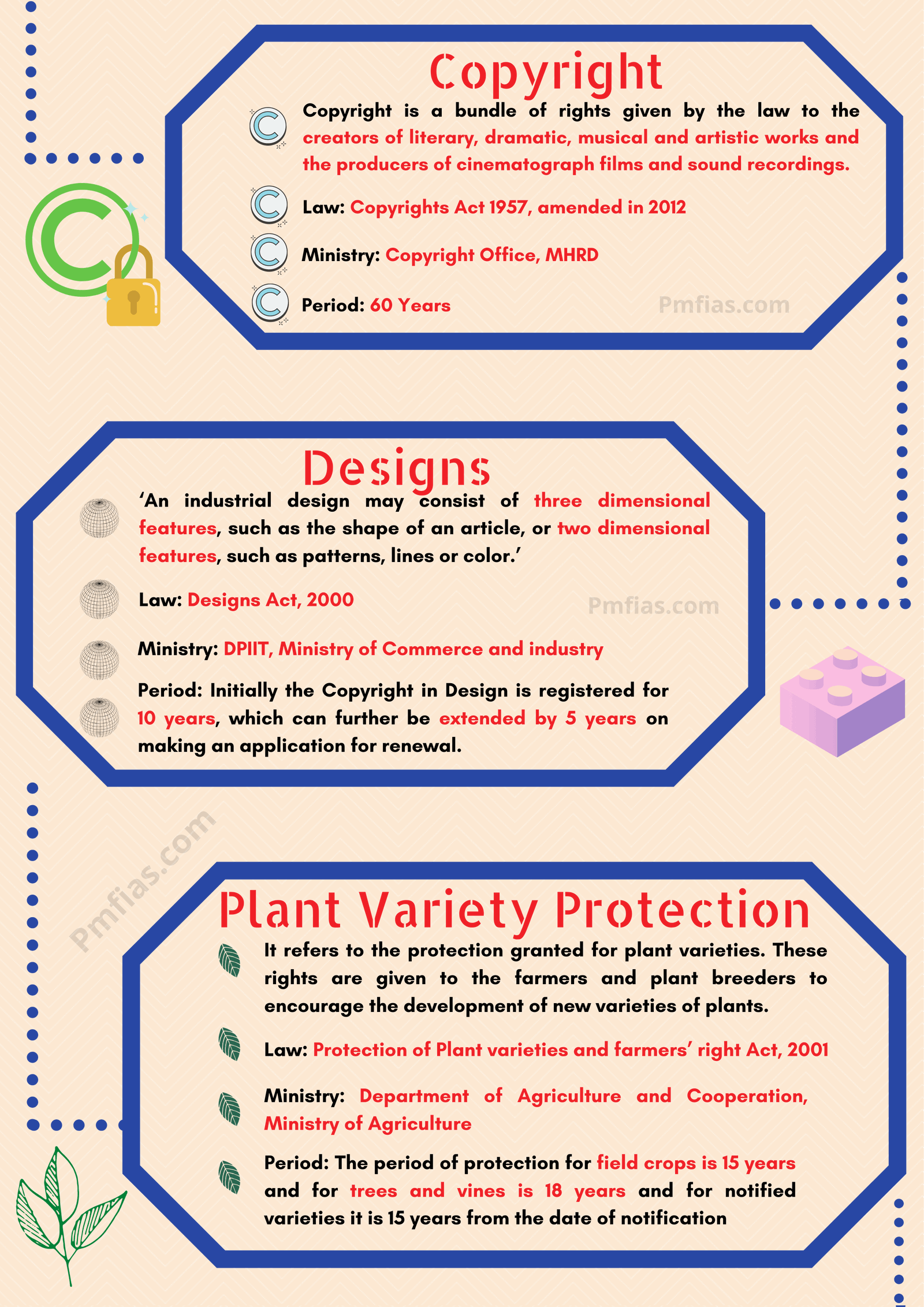
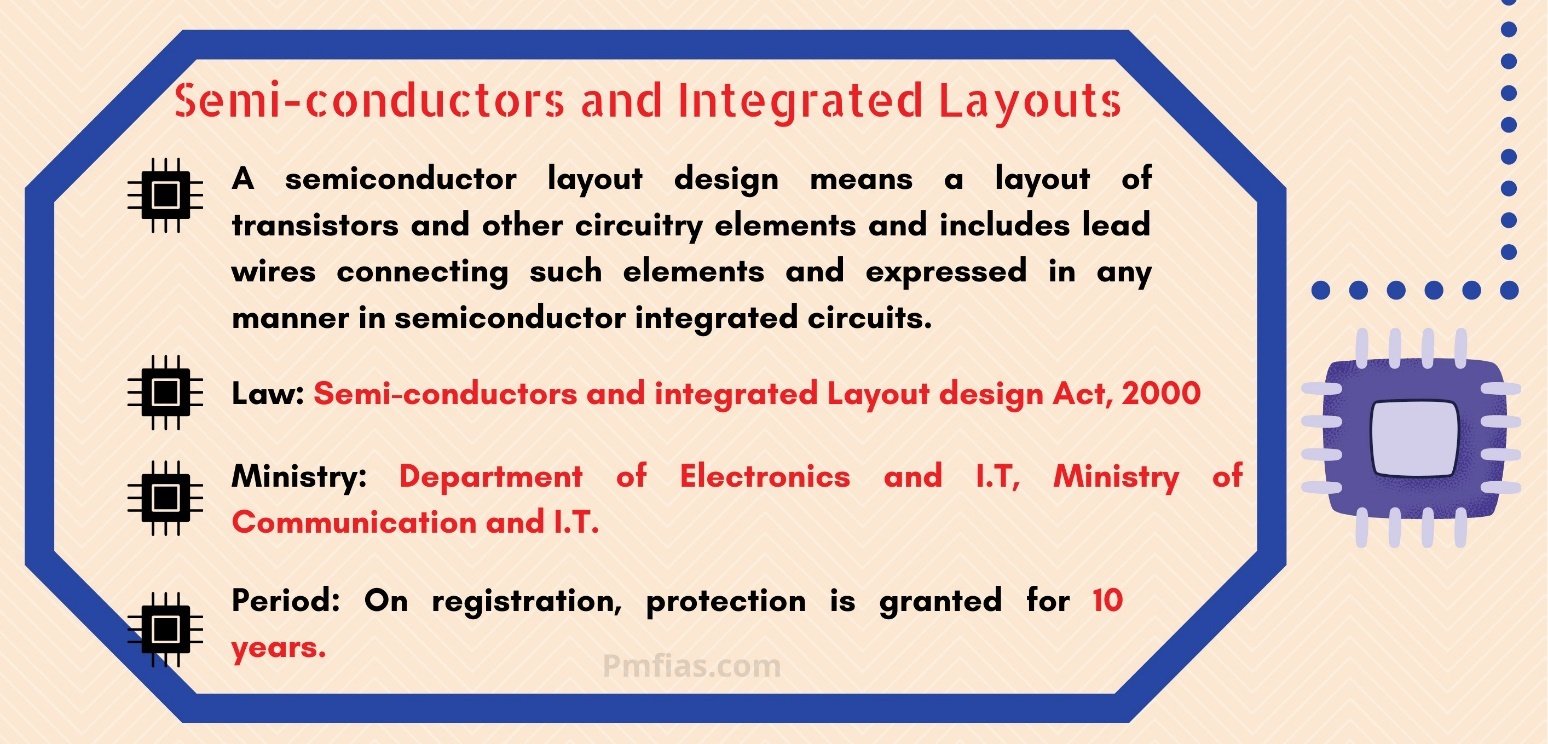
Patents
- A patent is an exclusive right granted for an invention, which is a new product or process that meets conditions of
- novelty,
- non-obviousness, &
- industrial use.
- A patent provides the owner with the right to decide how – or whether – the invention can be used by others.
Criteria for issuing Patents in India
- Novelty: it should be new (not published earlier + no prior Public Knowledge/ Public Use in India)
- Non obviousness: It must involve an inventive step (technical advanced in comparison to existing knowledge + non‐obvious to a person skilled in the relevant field of technology)
- Industrial use: It should be capable of Industrial application
- Patents in India are governed by “The patent Act 1970” which was amended in 2005 to make it compliant with TRIPS.
What cannot be patented?
- Frivolous Invention: Invention that harms public order/Morality/ health of animals, plants & humans
- Methods of agriculture or horticulture
- Traditional Knowledge
- Computer Program
- Inventions related to Atomic Energy
- Plants & Animals
- Mere discovery of scientific principle
Patent (Amendment) Rules, 2020
- The central government has published an amended Patent (Amendment) Rules, 2020.
- The new rules have amended the format of a disclosure statement that patentees & licensees are required to annually submit to the Patent Office.
- The format contains disclosing the extent to which they have commercially worked or made the patented inventions available to the public in the country.
- The disclosure is to be made in the Form 27 format as prescribed under the Patent Rules, 2003.
- The patentees & licensees as well as the Patent Office have blatantly disregarded this statutory requirement.
- There has been significant pressure from MNCs & the U.S. to do away with this requirement.
Criticism of Patent (Amendment) Rules, 2020
- The amendment has significantly weakened the requirement of submitting information in the disclosure.
- This could hamper the effectiveness of India’s compulsory licensing regime which depends on full disclosure of patent working information.
- This in turn could hinder access to vital inventions including life-saving medicines.
Industrial Designs
- An industrial design constitutes the ornamental or aesthetic aspect of an article/object.
- A design may consist of three-dimensional features, such as the shape or surface of an article, or of two-dimensional features, such as patterns, lines or colors.
- Industrial Designs in India are governed by “The Designs Act 2000”.
Copyright
- Copyright is a legal term used to describe the rights that creators have over their literary & artistic works.
- Works covered by copyright range from books, music, paintings, sculpture & films, to computer programs, databases, advertisements, maps & technical drawings.
- Copyrights in India are governed by “The Copyright Act, 1957”.
Trademarks
- A trademark is a sign capable of distinguishing the goods or services of one enterprise from those of other enterprises.
- Trademarks date back to ancient times when artisans used to put their signature or “mark” on their products.
- Trademarks in India are governed by Trade Marks Act 1999 which was amended in 2010.
Geographical Indications
- A GI tag is a legal recognition given primarily to an agricultural, natural or a manufactured product (handicrafts & industrial goods) originating from a definite geographical territory.
- GI tag conveys an assurance of quality & distinctiveness of a product, which is essentially attributable to the place of its origin.
- Most commonly, a geographical indication includes the name of the place of origin of the goods.
- Once the GI protection is granted, no other producer can misuse the name to market similar products.
- It also provides comfort to customers about the authenticity of that product.
- Geographical Indicators in India are governed by “The Geographical Indications of Goods (Registration & Protection) Act, 1999”.
What is the difference between a Geographical Indication (GI) & a Trademark?
- A trademark is a sign/word/phrase used by an entity to distinguish its goods & services from those of others.
- A geographical indication tells consumers that a product is produced in a certain place & has certain characteristics that are due to that place of production.
- A trademark gives the entity the right to prevent others from using the trademark.
- On the other hand, GI may be used by all producers who make their products in the place designated by a geographical indication.
Trade secrets
- Trade secrets are IP rights on confidential information which may be sold or licensed.
- The unauthorized acquisition use or disclosure of such secret information by others is regarded as an unfair practice & a violation of the trade secret protection.
- There is no specific law.
Plant Variety Protection
- It refers to the protection granted for plant varieties.
- These rights are given to the farmers & breeders to encourage the development of new varieties of plants.
- Plant variety protection in India is governed by “The Protection of Plant Varieties & Farmers’ Rights (PPV&FR) Act, 2001”.
Protection of Plant Varieties & Farmers’ Rights (PPVFR) Act, 2001
- PPVFR Act, 2001 has been enacted in India for giving effect to the TRIPS Agreement.
- The PPVFR Act retained the main spirit of TRIPS viz., IPRs as an incentive for technological innovation.
- However, the Act also had strong provisions to protect farmers’ rights.
- The act allows farmers to plant, grow, exchange & sell patent-protected crops, including seeds, & only bars them from selling it as “branded seed”.
- It recognised three roles for the farmer: cultivator, breeder & conserver.
- As cultivators, farmers were entitled to plant-back rights.
- As breeders, farmers were held equivalent to plant breeders.
- As conservers, farmers were entitled to rewards from a National Gene Fund.
|
Objectives of the PPVFR Act
- Facilitate an effective system for the protection of plant varieties & the rights of farmers.
- Encourage the development of new varieties of plants.
- Protect the rights of the farmers in respect of their contribution in conserving plant genetic resources.
- Facilitate the growth of the seed industry which will ensure the availability of high quality seeds.
Criticism of PPVFR Act, 2001
- Discourages research & innovation: PPVFR Act allows farmers to use patented varieties & hence private companies are not keen to bring new technology.
- India neither invests in public sector nor respects private & foreign players’ IPR (bad for business).
National IPR Policy, 2016
- The Policy aims to push IPRs as a marketable financial asset, promote innovation & entrepreneurship while protecting public interest.
- The plan will be reviewed every five years in consultation with stakeholders.
- To have strong & effective IPR laws, steps would be taken — including review of existing IP laws — to update & improve them or to remove anomalies & inconsistencies.
- The policy is entirely compliant with the WTO’s agreement on TRIPS.
- Department of industrial policy & promotion (DIPP) is the nodal agency for all IPR issues.
- The policy retains the provisions on Compulsory Licensing (CL) as well as preventing ever-greening of drug patents (Section 3(d) of India’s Patents Act).
- Under Indian Patents Act, a CL can be issued for a drug if the medicine is deemed unaffordable, among other conditions, & the government grants permission to qualified generic drug makers to manufacture it.
Objectives under policy are
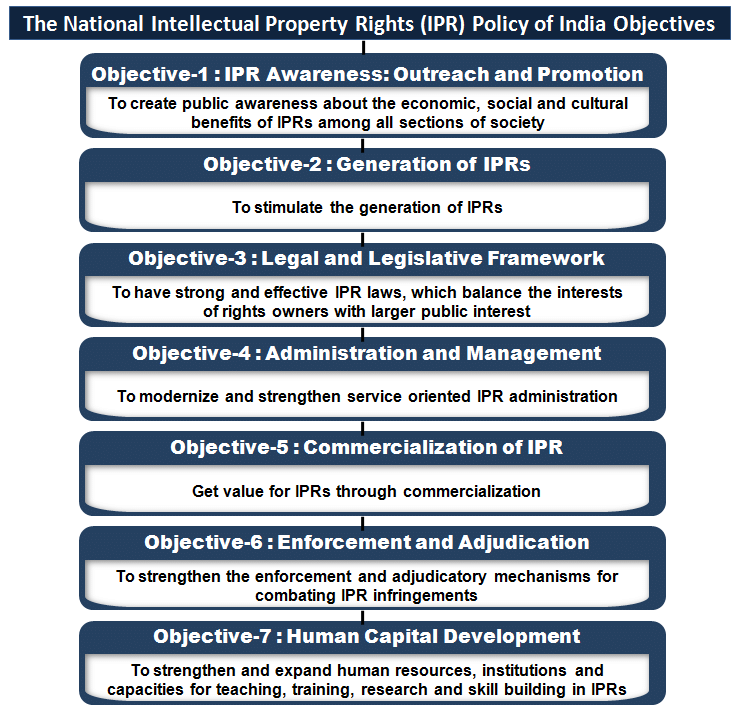
Intellectual Property Rights Issues: The Five Major Challenges Faced
- There are many IPR issues that one faces while getting IP rights in India. The issues are as follows:
Patent Evergreening Prevention
- One of the most important intellectual property rights issues challenges is the prevention of the evergreening of the patents for multinational companies.
- Evergreening is strategy for extending the term of granted patent which is about to expire without increasing therapeutic efficacy in order to retain royalties.
- As we know, the companies cannot evergreen their patents simply by making minor changes.
- So, section 3(d) in the Indian Patent Act (IPA) possess as one of the biggest issues with regards to IPR.
- This act bars the grant of patents to new forms of substances.
- This has discouraged investments from western countries.
Subsidies & IPR Issues
- A major form of subsidies includes food subsidy, fertilizer subsidy, education subsidy, etc.
- For the complete implementation of TRIPS agreements, one needs to reduce or eliminate these subsidies.
- Thus, GOI needs to create a balance between providing subsidies & providing IP rights in India.
The Product Patents Process
- A product patent protects a product.
- It offers high protection to the original inventor to reduce the competition for the same product.
- Whereas a process patent protects the process through which one manufactures the product & not the product.
- It reduces the element of monopoly in the market.
- As India is a part of the TRIPS agreement, the agreement requires all its members to shift their patent regime from process to product patent.
- This remains a challenge for India, as process patent would be more helpful to a country like India.
- This is since India is a developing country & ordinary people are struggling with basic necessities like food.
Protecting traditional knowledge
- Traditional knowledge, especially in the field of medicine, is like a gold mine.
- GOI is bound to protect traditional knowledge by not allowing MNC’s to get patents on traditional culture.
- Above all, the government has created a Traditional Knowledge Digital Library (TKDL) to prevent the patenting of traditional knowledge.
- So, this is one of the intellectual property rights issues in India.
Compulsory Licensing & Drug Price Control Order
- One of the most important intellectual property rights issues that the government needs to address is the use of compulsory licensing.
- Compulsory licenses are authorizations given to a third-party by the Government to make, use or sell a particular patented product without the need of the permission of the patent owner.
- The provisions regarding compulsory licenses are given in the Indian Patents Act, 1970 & in the TRIPS (Trade-Related Aspects of Intellectual Property Rights) Agreement.
- It is a relaxation available to the developing countries under the TRIPS agreement, something which organizations misuse sometimes.
- Moreover, under section 84 of the IPA, a company can acquire a compulsory license for “private commercial use” under certain circumstances.
- With the Drug Price Control Order, the company needs to justify the price of the drug with regards to investments.
- If someone plays foul, then the government has the right to intervene.
- Multinationals are asking the government to revoke this provision.
- However, the government is not ceding the demands to protect the interest of the masses.
Some other issues
- Trademark Violations: India has very high level of trademark counterfeiting against which the authorities in India do not take proper actions.
- Enforcement of IPR regulations is quite weak in the country because of two important reasons
- India is key exporter of counterfeit fake products such as foodstuffs, textiles, shoes, electronics etc
- Judicial delays in IPR disputes
- India maintains high custom duties on IP intensive products as advocated by western countries impacting the investment (US puts India into priority watch list i.e., special 301 report).
Related Topics
Cell for IPR Promotion & Management (CIPAM)
- CIPAM has been created as a professional body under the aegis of DIPP to take forward the implementation of the National IPR Policy 2016.
- Functions:
- CIPAM is working towards creating public awareness about IPRs in the country,
- Promoting the filing of IPRs through facilitation.
- Providing inventors with a platform to commercialize their IP assets &
- Coordinating the implementation of the National IPR Policy in collaboration with Government Ministries/Departments & other stakeholders.
IP Nani
- IP Nani was launched by Ministry of Commerce & Industry in 2018.
- It is a tech-savvy grandmother who helps the government & enforcement agencies in combating IP crimes with the help of her grandson “Chhotu” aka Aditya.
- The IP mascot will spread awareness about the importance of Intellectual Property Rights (IPRs) among people, especially children, in an interesting manner.





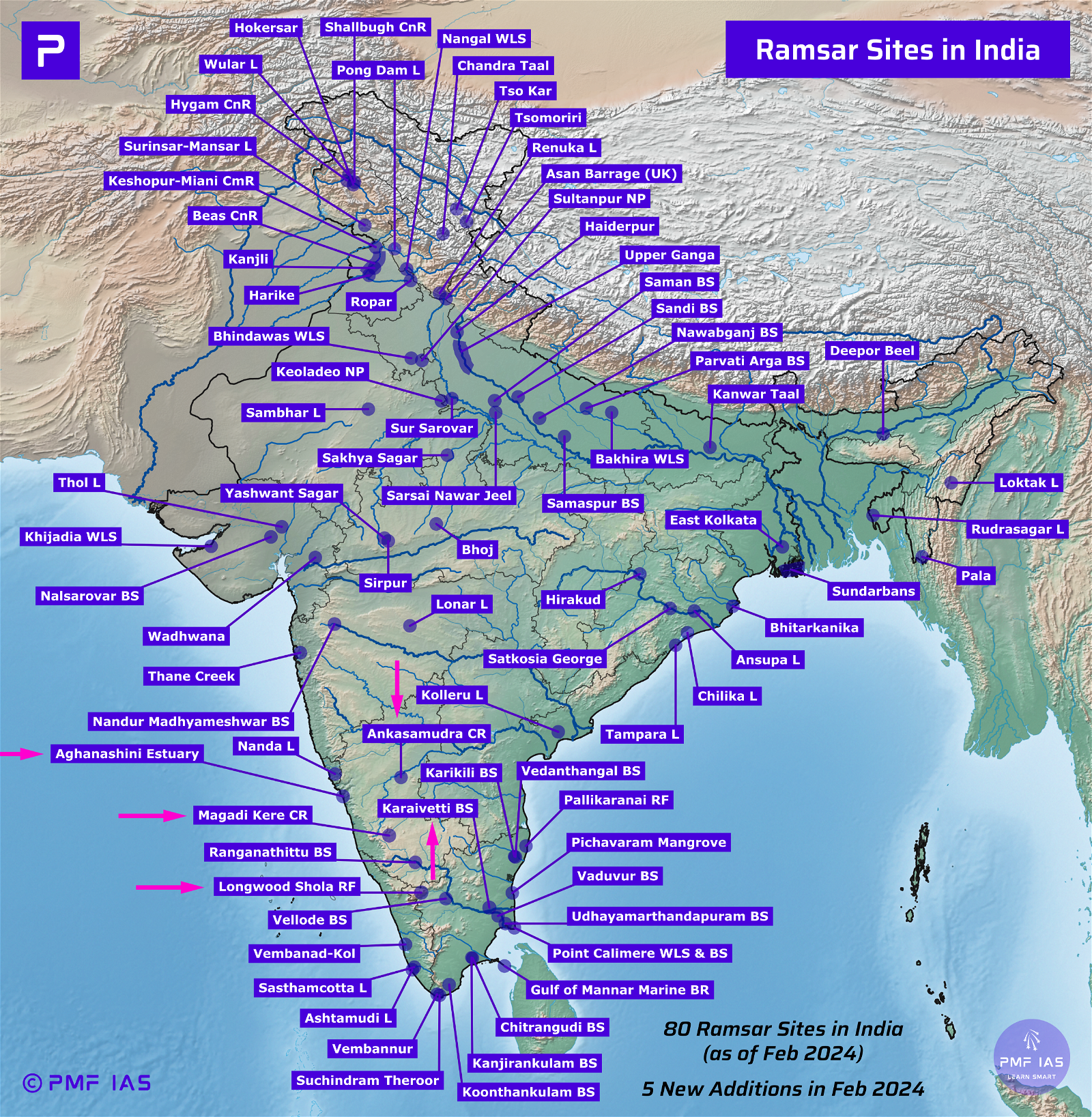




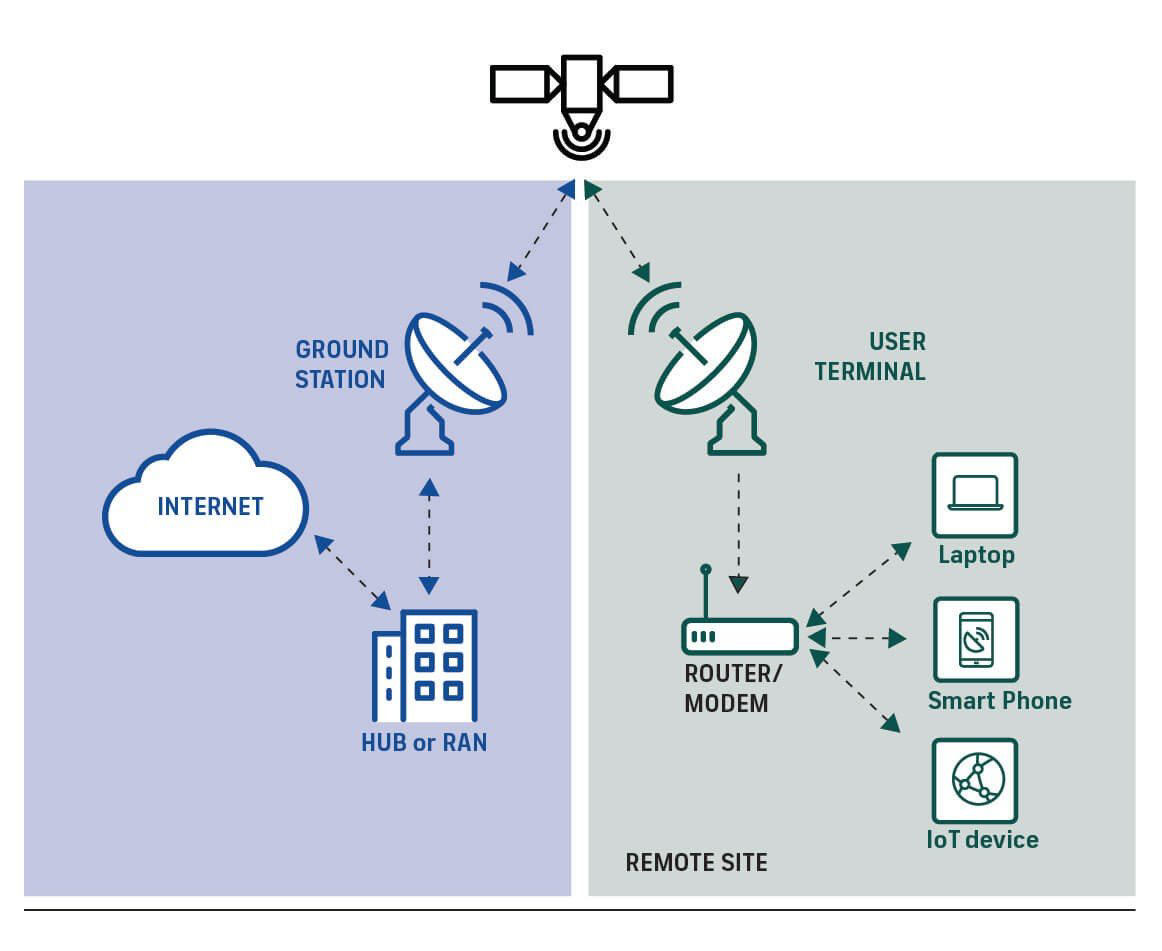
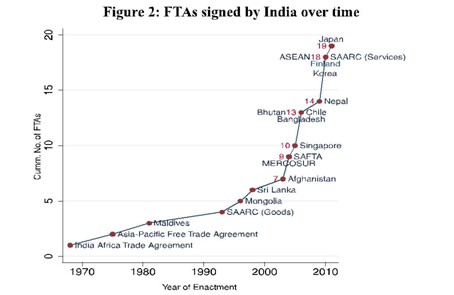




It’s really helpful for all aspirants of UPSC…Tnq so much ❤️❤️